|
|
Sento (lit. hot water for coins) is public bath, an institution still dominant in all Tokyo neighbourhoods. I took part of my information from a book I found last year about Sento Style.
Despite being a very japanese institution the popularity of sento among foreigners has caused the Sento Association to produce a manner poster with dos and donts. [sample]
|
 |

|
|
I recommend also Takara No Yu and Daikoku Yu, both in Kita Senju. A fairly modern Sento, Takaban no Yu, is found in Gakugei Daigaku.
|
|
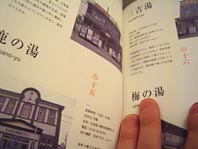
|
|
|
At big bookstores like 1st book in Tokyo you'll find some books on sento, cause sento is popular again, especially among young people.
|
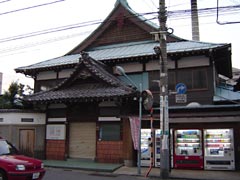 |
 |
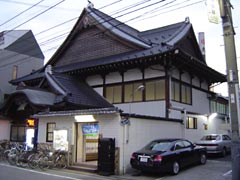 |
|
This is Takara no Yu in Kita Senju. It was closed when I arrived on Friday.
The temple style of the sento building is not traditional, but was established in Tokyo in the 1920s.
|
|
Round the corner was Daikoku Yu. The bath is simple classic style with a nice outdoor garden.
The entrance of the bath was moved to the right side during rennovation a few years ago.
|
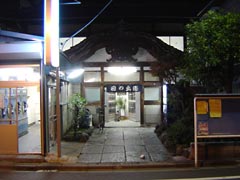 |
|
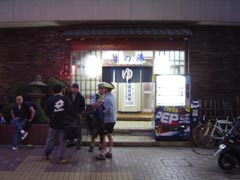 |
|
This is a Sento (Hinode no Yu?) not far from my hotel in Nihontsutsumi. Note the coin washers on the left. People leave their clothes for a round while having a bath.
|
|
The entrance of Azabu Juban Onsen. Onsen is real hot spring, while Sento is just hot water. Nishi Azabu is a very posh area, the onsen is still popular.
|
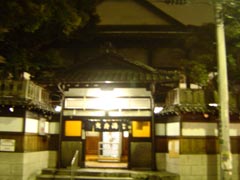 |
|
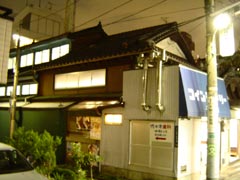 |
|
Hikifune Yu, located in a very oldfashioned neighbourhood in Kyojima.
|
|
A sento in Sendagaya/Yoyogi, just five minutes from the center of Shinjuku.
|
|
|
 Find the Sento in your neighbourhood Find the Sento in your neighbourhood
 Sento manners in Japanese, more colorful [site] Sento manners in Japanese, more colorful [site]
 Before tubs became widespread in homes throughout Japan, taking a bath meant heading down the street, soap dish, shampoo, and towel in hand, to a local public bath. These baths have functioned for centuries as an urban equivalent of the natural hot springs that the Japanese have always enjoyed in more rural settings. But over the past three decades, Japan's city bathhouses, or sento (literally meaning "coin bath"), have declined rapidly. From 2,687 bathhouses that operated in Tokyo in 1968, the current number has fallen by roughly half, to 1,349. Before tubs became widespread in homes throughout Japan, taking a bath meant heading down the street, soap dish, shampoo, and towel in hand, to a local public bath. These baths have functioned for centuries as an urban equivalent of the natural hot springs that the Japanese have always enjoyed in more rural settings. But over the past three decades, Japan's city bathhouses, or sento (literally meaning "coin bath"), have declined rapidly. From 2,687 bathhouses that operated in Tokyo in 1968, the current number has fallen by roughly half, to 1,349.
The principal cause of this decline is acknowledged to be the near universal installation of bathing facilities in homes. But sento have not completely died out, and some are doing better business than ever. The success of these bathhouses is driven not so much by customers' desire for an old-time bathing experience as by a modern business spirit that appeals to people's interest in new types of urban spas.(jinjapan.org)
 No one knows exactly when the public bathhouse started as a business in Japan. The earliest confirmed record of the word "sento" was in a document from the Nichiren Buddhist sect written in 1266. There is also written record of Emperor Godaigo establishing a sento during his reign of 1321-24. No one knows exactly when the public bathhouse started as a business in Japan. The earliest confirmed record of the word "sento" was in a document from the Nichiren Buddhist sect written in 1266. There is also written record of Emperor Godaigo establishing a sento during his reign of 1321-24.
Then in 1591, a person named ISE Yoichi was the first to open a sento as a business in Edo (Tokyo). It was adjacent to a river. In those days, the bathing room had no windows and was completely dark. People already in the bath "cleared their throats" to make their presence known to the next person entering the bath. The entrance to the bathing room was a low, 80 cm-high opening through which you almost had to crawl through. It was small and right above the floor to minimize the escaping of heat and steam. There were no water faucets either. From the Meiji Period (1868-1912), the sento began to have a lounging area on the second floor for people to rest after the bath.
Incidentally, during the Edo Period, the sento was called yuya in Edo and furoba in the Kansai area (Osaka). In Edo, a bow and arrow was also used to indicate a sento because it had the same pronunciation as yuya. Mixed bathing was also the norm during this time.
One interesting development of sento culture was the yuna or bath women. Appearing as early as the 18th century, they were prostitutes working under the guise of back scrubbers for men in the bathhouse. The women wore normal cotton kimono and scrubbed backs during normal hours, but changed into sexy clothing for customers in the evenings. (PhotoGuide Japan)
|








